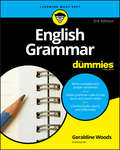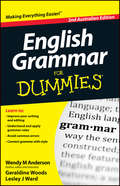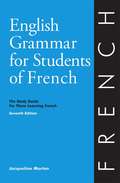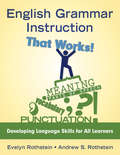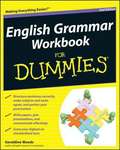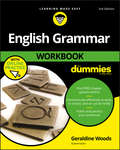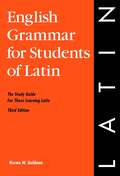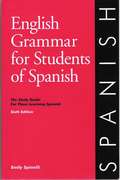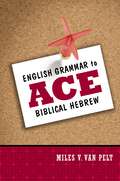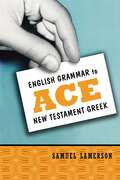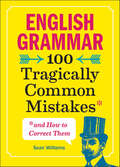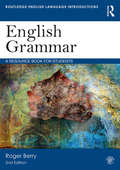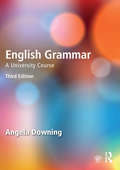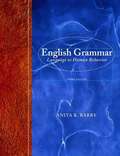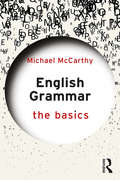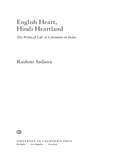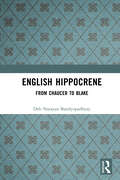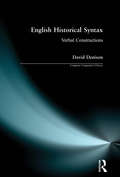- Table View
- List View
English Grammar For Dummies
by Geraldine WoodsGet the last word on English grammar Grasping the intricacies of the English language doesn't need to be tricky, and this down-to-earth guide breaks everything down in ways that make sense—Revealing rules, tips, and tricks to eliminate confusion and gain clarity, English Grammar For Dummies gives you everything you need to communicate with confidence! Good grammar lays the foundation for speaking and writing clearly. This easy-to-follow book will help you become a more articulate, effective communicator. Covering everything from the building blocks of a sentence to those pesky rules of punctuation, it offers the practical guidance you need to communicate in a way that would make any English teacher proud. Improve your speaking skills Clearly compose written communications Get the latest techniques for continuous improvement Write a winning college entrance exam or compelling business presentation Stop worrying about the grammar police and become more confident with your words!
English Grammar For Dummies
by Geraldine Woods Lesley J. Ward Wendy M. AndersonImprove the writing and speaking skills you use every day Graceless with grammar? Perplexed by punctuation? Have no fear! This second Australian edition of English Grammar For Dummies explains everything from basic sentence structure to the finer points of grammar. Packed with expert advice, this book will help you to communicate more effectively and make the right impression every time. Structure sentences correctly — learn everything from making verbs agree to understanding clauses Avoid and fix common mistakes — find out how to revise the things your grammar checker underlines Punctuate like a professional — explore the correct use of commas, apostrophes, colons, semicolons and dashes Polish your writing style — discover how good grammar and good style go hand in hand Open the book and find: Ways to accessorise with adjectives and adverbs Tips for pairing the correct pronoun with the noun Advice about how to use numerals in documents Hints for writing emails and slide presentations Explanations of errors missed by spell checkers Learn to: Improve your writing and editing Understand and apply grammar rules Avoid common errors Connect grammar with style
English Grammar For Students of French (Seventh Edition)
by Jacqueline MortonEnglish Grammar for Students of French (EGSF) is a bridge from English grammar to French grammar. Once you have learned a part of speech or a function as it applies to English, it will be easier for you to understand what is being introduced in your French textbook. Each short chapter is divided into two sections, In English and ln French, both explain the same grammar point and alert you to the similarities and differences between the two languages. You will find step-by-step tools to apply grammar rules and to get from an English structure to a French structure.
English Grammar Instruction That Works!: Developing Language Skills for All Learners
by Andrew S. Rothstein Evelyn B. RothsteinOffering a fun, engaging approach to grammar instruction, this guide includes clear explanations of grammatical terms and practical activities for all students, including English language learners.
English Grammar Pedagogy: A Global Perspective (ESL & Applied Linguistics Professional Series)
by Barbara M. BirchDesigned for ESL and ELT pedagogy courses around the world, this text describes English grammar from a World Englishes perspective. It is distinguished by its focus on the social setting for English as a global language, the latest thinking about grammatical theory, and new theories of how first and second languages are learned and taught. The fundamental premise is that teaching and learning grammar cannot be isolated from the local, regional, and global sociocultural contexts in which the teaching and learning take place. Part I presents different attitudes toward English as a global language and some challenges that learners of English share no matter where they are in the world. Part II is about the features of English that educated speakers consider the most likely and probable in Academic English. Part III describes the flexible and fluid features of English that might be susceptible to change or modification over time. Each chapter includes engaging Study, Discussion, and Essay Questions and Activities.
English Grammar Workbook For Dummies
by Geraldine WoodsGet some good grammar practice-and start speaking and writing wellGood grammar is important, whether you want to advance your career, boost your GPA, or increase your SAT or ACT score. Practice is the key to improving your grammar skills, and that's what this workbook is all about. Honing speaking and writing skills through continued practice translates into everyday situations, such as writing papers, giving presentations, and communicating effectively in the workplace or classroom.In English Grammar Workbook For Dummies you'll find hundreds of fun problems to help build your grammar muscles. Just turn to a topic you need help with-from punctuation and pronouns to possessives and parallel structure-and get out your pencil. With just a little practice every day, you'll be speaking correctly, writing confidently, and getting the recognition you deserve at work or at school.Hundreds of practice exercises and helpful explanationsExplanations mirror teaching methods and classroom protocolsFocused, modular content presented in step-by-step lessonsEnglish Grammar Workbook For Dummies will empower you to structure sentences correctly, make subject and verbs agree, and use tricky punctuation marks such as commas, semicolons, and apostrophes without fear.
English Grammar Workbook For Dummies, with Online Practice
by Geraldine WoodsImprove your English grammar You have nothing to lose and everything to gain by using proper English language and grammar. The ability to articulate and communicate effectively is a valuable asset in all aspects of life. From writing a research paper to giving a presentation at work or just holding a casual conversation with friends or family, strong verbal and written skills are necessities in everyday communication. English Grammar Workbook For Dummies is the perfect solution for sharpening the tools in your grammar kit, with lessons and plenty of practice opportunities to help reinforce learning. Whether you need to brush up on the finer points of punctuation, need help making sense of those pesky parts of speech—or anything in between—this approachable guide makes it fast and easy. • Find FREE quizzes for every chapter online • Handle pronouns with grace • Master plurals and possessives • Improve your proofreading skills Everyone benefits from using proper grammar and speech, and now you can too!
English Grammar for Students of Latin: The Study Guide for Those Learning Latin
by Norma W. GoldmanDon't let grammar stand in the way of your learning Latin Are you starting to learn Latin and looking for an easy grammar book? Are you a student trying to understand the English grammar terms used in your Latin textbook? Are you a Latin language teacher who is tired of spending class time teaching English grammar? Are you a parent looking for a Latin grammar book to support your kids learning Latin? Learn Latin with this proven method The 7th edition of the popular O&H Study Guide Series makes Latin language learning easier by teaching Latin grammar from the point of view of a language you already speak, English. This concise English grammar book for beginning students of Latin introduces basic grammar. Each chapter is divided into two sections: first explaining how a grammar point works in English and then how it works in Latin taking you step-by-step from English to Latin. This easy-to-follow Latin grammar book is designed to be used as study guide for adult, high-school and college students learning Latin.
English Grammar for Students of Spanish (Seventh Edition)
by Emily SpinelliThousands of students have found this book the ideal way to master and upgrade their Spanish grammar.
English Grammar to Ace Biblical Hebrew
by Miles V. Van PeltEnglish Grammar to Ace Biblical Hebrew enables students of biblical Hebrew to grasp the basic concepts of English grammar that are needed in order to be able to transfer these concepts to biblical Hebrew. One of the biggest problems students encounter learning biblical languages, especially Hebrew, is that they have either forgotten or simply do not know their English grammar. Concepts such as verb tense and voice, relative pronouns, antecedents, adjectival substantives, and the like, sound like familiar terms, but may seem foreign when it's time to put them to practice. With chapters such as, "To Be or Not To Be, that is the Infinitive" and "Pronouns: Grammatical Stunt Doubles," this book is both clever and engaging. All Hebrew students will become better translators--and ultimately better pastors and leaders--with the help of this book. Tips for studying Hebrew, a glossary, and a list of additional Hebrew resources is also provided. This book is a companion to English Grammar to Ace New Testament Greek by Samuel Lamerson.
English Grammar to Ace New Testament Greek
by Samuel LamersonIf you think that . . . • Aorist is a major artery of the heart • Clause is the surname of the fat guy in the red suit • Syntax is Uncle Sam’s slice of alcohol and tobacco sales . . . then you need English Grammar to Ace New Testament Greek. It’s designed to help you get a quick brush-up on the English grammar you’ve either forgotten or never quite learned, in a way that ties directly to your first-year Greek studies. With chapters such as “You Ain’t Nothing but a Noun Dog” and “Inflection: Trouble Understanding Yoda You Have, Yes?” this colorful, entertaining book compares elements of English grammar with similar elements in Greek grammar. It can either be used as a one-week intensive study to prepare for Greek grammar, or be readily incorporated into actual Greek studies. English Grammar to Ace New Testament Greek features: • A brief summary of the scope of English grammar • Short, easy-to-read chapters • An introductory devotion in every chapter • Lessons coordinated with Mounce’s Basics of Biblical Greek • Tips for vocabulary memorization and sentence diagramming • Glossary
English Grammar: 100 Tragically Common Mistakes (and How to Correct Them)
by Sean WilliamsThe practical English grammar guide for perfect writing.Gone are the days when you worry about embarrassing yourself with pesky misplaced modifiers or dreaded double negatives. Next time you have a nagging grammar question, pick up this practical guide and write with clarity and confidence.English Grammar spares you the lessons and cuts right to the answers. Designed for fast reference, this book makes it easy to avoid the most cringe-worthy mistakes in the English language—and maybe even make your grade school grammar teacher proud.Inside English Grammar:English Grammar goofs—Avoid falling into the most common traps with guidelines for incomplete sentences, possessive pronouns with gerunds, dangling modifiers and more.Word mix-ups—Learn the difference between common word misuses like sex vs. gender, its and it's, whose and who's, the list goes on…Write with style—Make a good (and grammatically correct) impression with every sentence you pen using these easy writing hacks and suggestions.Everyone makes mistakes—but with this English grammar guide you'll make a lot fewer of them. Period.
English Grammar: A Resource Book for Students (Routledge English Language Introductions)
by Roger BerryRoutledge English Language Introductions cover core areas of language study and are one-stop resources for students. Assuming no prior knowledge, books in the series offer an accessible overview of the subject, with activities, study questions, sample analyses, commentaries and key readings – all in the same volume. The innovative and flexible 'two-dimensional' structure is built around four sections – introduction, development, exploration and extension –which offer self-contained stages for study. Each topic can also be read across these sections, enabling the reader to build gradually on the knowledge gained. English Grammar: provides a wide-ranging introduction to English grammar, drawing on a variety of international authentic texts, including newspapers, novels and academic texts, to help learners understand concepts and theories in more depth; is written in clear, concise prose in order to present basic concepts and key terms in an accessible way to learners with little or no background in grammar instruction; emphasises the autonomy of the learner through activities and exercises which are suited to both native speakers and learners of English alike; includes a selection of readings from key academics in the field including Michael Halliday, Michael McCarthy, Caroline Coffin and John Sinclair. Drawing on the strengths of the original textbook, this second edition features: new readings from Christian Jones, Daniel Waller and Thomas E. Payne; revised questions, suggestions and issues to consider; and a brand new companion website featuring interactive audio files of authentic spoken English, links to further reading and new grammar tasks. Written by an experienced teacher and researcher, this accessible textbook is an essential resource for all students of English language and linguistics.
English Grammar: A University Course
by Angela DowningThis best-selling comprehensive descriptive grammar forms a complete course, ideal for all students studying English Language, whether on a course or for self-study. Broadly based on Hallidayan systemic-functional grammar but also drawing on cognitive linguistics and discourse analysis, English Grammar is accessible, avoiding overly theoretical or technical explanations. Divided into 12 self-contained chapters based around language functions, each chapter is divided into units of class-length material. Key features include: Numerous authentic texts from a wide range of sources, both spoken and written, which exemplify the grammatical description. Clear chapter and module summaries enable efficient class preparation and student revision. Extensive exercises with a comprehensive answer key. This new edition has been thoroughly updated with new texts, a more user-friendly layout, more American English examples and a companion website, providing extra tasks, a glossary and a teachers‘ guide. This is the essential coursebook and reference work for all native and non-native students of English grammar on English language and linguistics courses.
English Grammar: Language as Human Behavior (3rd Edition)
by Anita K. BarryApproaching grammar as a process and not a product, this text engages readers in a conversation about English that will help them reflect on how their language works and understand the social judgments that accompany language use--making them feel they are active participants in shaping their language rather than passive victims of grammar rules that someone imposes on them. Employing the terminology of traditional grammar combined with the insights gained by modern linguistic analysis, it describes English as an instrument of communication, and lays the necessary groundwork for thinking about language so that students can extend what they learn to new situations and apply their knowledge of language in ways most useful to them. Three different types of exercises support the learning and review processes and motivate readers to think, talk, and write about English with increasing confidence and sophistication as the term progresses.
English Grammar: The Basics (The Basics)
by Michael McCarthyEnglish Grammar: The Basics offers a clear, non-jargonistic introduction to English grammar and its place in society. Rather than taking a prescriptive approach, this book helps the reader become aware of the social implications of choices they make to use standard or non-standard (regional/dialect) forms. Readers will consider: • what grammar is and how it fits into the structure of language; • how grammar functions in the school curriculum, the press, broadcasting and social media, as well as how these outlets reflect and reinforce our attitudes towards grammar; • differences between speech and writing, as well as between formality and informality; • major different approaches to theorising and describing grammar from important grammarians, including Noam Chomsky and Michael Halliday. Featuring a glossary of key terms and practical tips and insights from the author's 50+ years of language teaching experience around the world, this book is for anyone who has ever found themselves questioning the ‘rules’ of the English language.
English Heart, Hindi Heartland
by Rashmi SadanaEnglish Heart, Hindi Heartland examines Delhi's postcolonial literary world--its institutions, prizes, publishers, writers, and translators, and the cultural geographies of key neighborhoods--in light of colonial histories and the globalization of English. Rashmi Sadana places internationally recognized authors such as Salman Rushdie, Anita Desai, Vikram Seth, and Aravind Adiga in the context of debates within India about the politics of language and alongside other writers, including K. Satchidanandan, Shashi Deshpande, and Geetanjali Shree. Sadana undertakes an ethnographic study of literary culture that probes the connections between place, language, and text in order to show what language comes to stand for in people's lives. In so doing, she unmasks a social discourse rife with questions of authenticity and cultural politics of inclusion and exclusion. English Heart, Hindi Heartland illustrates how the notion of what is considered to be culturally and linguistically authentic not only obscures larger questions relating to caste, religious, and gender identities, but that the authenticity discourse itself is continually in flux. In order to mediate and extract cultural capital from India's complex linguistic hierarchies, literary practitioners strategically deploy a fluid set of cultural and political distinctions that Sadana calls "literary nationality." Sadana argues that English, and the way it is positioned among the other Indian languages, does not represent a fixed pole, but rather serves to change political and literary alliances among classes and castes, often in surprising ways.
English Hippocrene: From Chaucer to Blake
by Deb Narayan BandyopadhyayThis book is a comprehensive introduction to English poetry, tracing its evolution from the Age of Chaucer to the Romantic Period. Designed especially for undergraduate and graduate students who are second-language learners in South and Southeast Asia, it fosters a deeper appreciation of English literary history and its aesthetic foundations.Each chapter offers a well-structured overview, beginning with the historical, social, political, and philosophical contexts that shaped the literature of the time. This is followed by close readings of representative poems, highlighting key themes, poetic forms, and stylistic features. The analytical framework helps learners understand not just the content of the poems, but also the broader cultural forces that influenced their creation and reception.Subjects covered include: Major poets and literary movements from Chaucer to the Romantics Historical and cultural contexts of poetic works Thematic concerns and philosophical underpinnings Guided analysis of selected poems with discussion prompts Ideal for classroom use or independent study, this book is a valuable resource for students seeking both knowledge and inspiration in their study of English poetry.
English Historical Linguistics: Approaches and Perspectives (Handbücher Zur Sprach- Und Kommunikationswissenschaft / Handbooks Of Linguistics And Communication Science (hsk) Ser. #34/2)
by Brinton Laurel J.Written by an international team of leading scholars, this engaging textbook on the study of English historical linguistics is uniquely organized in terms of theoretical approaches and perspectives. Each chapter features textboxes, case studies, suggestions for further reading and exercises, enabling students to understand the strengths and weaknesses of each approach and guiding them on undertaking further research. The case studies and exercises guide students in approaching and manipulating empirical data, providing them with hands-on experience of conducting linguistic research. An extensive variety of approaches, from traditional to contemporary, is treated, including generative approaches, historical sociolinguistic and pragmatic approaches, psycholinguistic perspectives, grammaticalization theory, and discourse-based approaches, as well as perspectives on standardization and language variation. Each chapter applies the concepts discussed to data from the history of English, and a glossary of key terms enables easy navigation and quick cross-referencing. An essential resource for advanced undergraduate and graduate students of the history of English linguistics.
English Historical Syntax (Longman Linguistics Library)
by David DenisonThis study brings together many of the resources needed for the exploration of English historical syntax and deals with many of the important changes in English sentence structure from Old English to present. It also features a survey of published research from both classical and modern linguistic traditions, as well as new research by the author. Provides guidance on methodology, important reference materials, and the general history of the English language.
